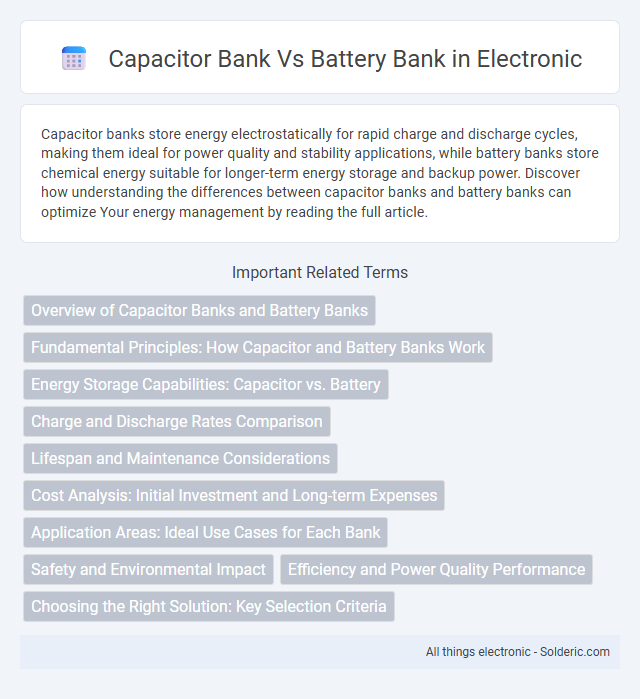Capacitor banks store energy electrostatically for rapid charge and discharge cycles, making them ideal for power quality and stability applications, while battery banks store chemical energy suitable for longer-term energy storage and backup power. Discover how understanding the differences between capacitor banks and battery banks can optimize Your energy management by reading the full article.
Comparison Table
| Feature | Capacitor Bank | Battery Bank |
|---|---|---|
| Primary Function | Energy storage for reactive power and power factor correction | Energy storage for DC power supply and backup |
| Energy Storage Type | Electrostatic field | Chemical energy |
| Energy Density | Low energy density | High energy density |
| Charge/Discharge Speed | Very fast (milliseconds) | Slower (minutes to hours) |
| Typical Applications | Power factor correction, voltage stabilization | Backup power, renewable energy storage, electric vehicles |
| Lifespan | Long cycle life (100,000+ cycles) | Limited cycle life (500-2000 cycles) |
| Maintenance | Low maintenance | Regular maintenance required |
| Environmental Impact | Minimal hazardous materials | Potentially toxic chemicals and disposal issues |
| Cost | Lower initial cost, higher power applications | Higher initial cost, energy-focused applications |
Overview of Capacitor Banks and Battery Banks
Capacitor banks store electrical energy as an electrostatic field and excel in providing rapid bursts of power to stabilize voltage and improve power factor in electrical systems. Battery banks, composed of multiple cells connected in series or parallel, store chemical energy and deliver sustained power output, making them ideal for long-term energy storage and backup power. Your choice between the two depends on whether you need short-term power conditioning or extended energy supply.
Fundamental Principles: How Capacitor and Battery Banks Work
Capacitor banks store electrical energy as an electrostatic field between plates, releasing it rapidly to smooth voltage fluctuations and improve power factor in AC systems. Battery banks store chemical energy through electrochemical reactions within cells, providing sustained DC power discharge over extended periods. While capacitors deliver quick bursts of energy for transient demands, batteries supply steady, long-duration power essential for backup and off-grid applications.
Energy Storage Capabilities: Capacitor vs. Battery
Capacitor banks store energy electrostatically, offering rapid charge and discharge cycles with high power density but limited energy capacity, making them ideal for short bursts of energy. Battery banks store energy chemically, providing higher energy density and longer discharge durations suitable for sustained power supply. Your choice depends on whether you require quick energy release or extended energy storage for your application.
Charge and Discharge Rates Comparison
Capacitor banks offer significantly faster charge and discharge rates than battery banks, making them ideal for applications requiring rapid energy delivery and absorption. Battery banks store energy chemically, resulting in slower charge and discharge times but higher energy density for long-term power supply. Your choice between capacitor and battery banks depends on whether short bursts of power or sustained energy storage are critical for your application's performance.
Lifespan and Maintenance Considerations
Capacitor banks generally offer longer lifespans, often exceeding 20 years, due to their robust construction and minimal chemical degradation, requiring only periodic inspections and replacement of individual capacitors. Battery banks, especially lead-acid or lithium-ion types, typically have shorter lifespans ranging from 5 to 15 years and demand regular maintenance such as electrolyte level checks, equalization charging, and temperature monitoring to prevent capacity loss. The maintenance intensity and replacement frequency of battery banks significantly impact their total cost of ownership compared to the relatively low-maintenance capacitor banks.
Cost Analysis: Initial Investment and Long-term Expenses
Capacitor banks generally have a lower initial investment compared to battery banks due to simpler construction and fewer materials required. Over the long term, capacitor banks incur minimal maintenance costs and have longer lifespans, whereas battery banks often face higher expenses from replacements, charging infrastructure, and degradation over time. Evaluating total cost of ownership, including energy efficiency and operational lifespan, reveals that capacitor banks can offer more cost-effective solutions in applications requiring quick charge and discharge cycles.
Application Areas: Ideal Use Cases for Each Bank
Capacitor banks are ideal for applications requiring rapid energy discharge and power factor correction in industrial settings, such as motor startup and voltage stabilization. Battery banks excel in energy storage solutions needing sustained power supply, including renewable energy integration, backup power systems, and off-grid applications. While capacitor banks support short bursts of high power, battery banks are optimized for longer-duration energy delivery.
Safety and Environmental Impact
Capacitor banks offer enhanced safety due to their lower risk of thermal runaway and minimal chemical leakage compared to battery banks, which contain hazardous materials like lead or lithium that pose fire and environmental hazards. Capacitors have a longer lifespan and generate less toxic waste, reducing environmental impact and disposal concerns typically associated with battery banks. Your choice of energy storage should consider these safety and ecological factors to ensure sustainable and secure power management.
Efficiency and Power Quality Performance
Capacitor banks improve power quality by providing reactive power compensation, reducing voltage fluctuations, and minimizing power losses, which enhances overall efficiency in electrical systems. Battery banks excel in energy storage and stable power supply, supporting load leveling and backup during power interruptions but typically have lower power quality correction capabilities compared to capacitor banks. For optimal system performance, capacitor banks are preferred for reactive power management, while battery banks are essential for storing and supplying real energy over time.
Choosing the Right Solution: Key Selection Criteria
When selecting between a capacitor bank and a battery bank, key criteria include energy storage capacity, response time, lifecycle, and application requirements. Capacitor banks excel in rapid charge and discharge cycles, making them ideal for power factor correction and short-term energy bursts, while battery banks offer higher energy density and longer discharge durations suited for continuous power supply and backup. Your choice depends on balancing the need for quick energy delivery versus sustained energy storage in line with operational goals.
Capacitor Bank vs Battery Bank Infographic

 solderic.com
solderic.com